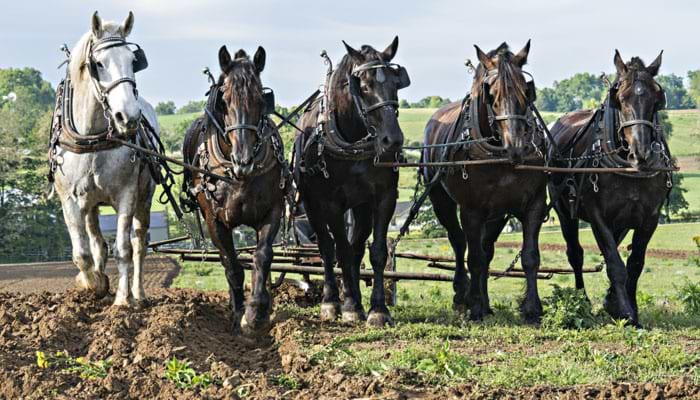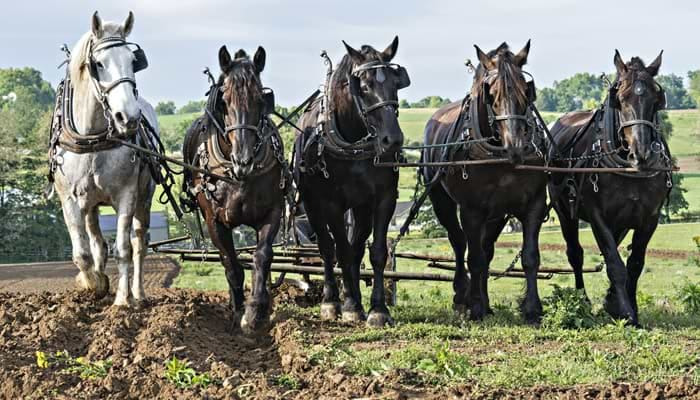
The role of the horse has changed dramatically over the past two centuries. In the mid-19th century, the horse was mainly a working animal and rarely became a family pet. Before the days of motorised transport and agricultural machinery, horses were vital to keeping society operating efficiently.
They were also used during wars, to carry the troops and haul weapons, up until the time of World War I. Today, you're more likely to find a horse being ridden for pleasure than pulling a plough, but despite modern advances in technology, there are still a number of working horses in the UK.

© Cynthia Baldauf / Adobe Stock
Farm horses
In the 1800s, horses were widely used on farms across Britain in a role that began way back in the eleventh century. They carried out many tasks, including transporting goods and ploughing fields. After English farmer Jethro Tull invented the seed drill in 1701, the horse was also used for planting seeds.
Cutting costs for the farmer, horses reduced the need for manual labourers on farms, while supplying plenty of manure to boost the crops. The modern-day tractor was developed during the 1920s, replacing the need for horses on larger farms.
By the 1940s, after World War II, the use of farm horses declined further, as even smaller farms began to use tractors and other mechanised machinery. Today, relatively few horses are used for traditional farming in the UK, although they are still used in some countries, such as in the Amish community in the United States.
Transport
In the mid-19th century, horses were vital for transport. They were used not only by individuals, for riding and pulling private carriages, but also for public transport. This practice continued into the early 20th century.
In 1900, more than 300,000 horses kept the City of London on the move. They pulled private carriages, taxi cabs, buses, delivery vans, milk floats and trams. Their role in providing transport in the growing city was crucial.
By the end of the Great War, motorised vehicles gradually took over the jobs that horses had traditionally fulfilled and motorised taxi cabs soon outnumbered horse-drawn carriages. Some small traders such as greengrocers, rag and bone men and coal men continued to use horse-drawn carriages to transport goods.
Horse-drawn buses and trams had disappeared from London by the 1920s. Modern roads, with their hard surfaces, were unsuitable for horses.
The working horses were retired and a large number of the London horses ended up at The Home of Rest for Horses, run by the Horse Trust charity. Some suffered from lameness, which had been caused by pounding the new roads.
Barges
Horse-drawn barges graced Britain’s waterways for many years, transporting both passengers and goods, such as coal and iron ore. The practice died out as late as the mid-20th century, despite the introduction of motorised barges many years before this.
Previously, goods had been transported by horse-drawn carts, but after the Industrial Revolution began, loads became heavier and this was no longer feasible. Even a strong horse could pull only around one ton of coal or iron ore by road.
As the demand from factories outstripped resource, suppliers realised a horse could pull up to 50 times more iron ore or coal on a barge on the river. This was considered to be safer for the horses too, since they would not have to go up and down steep hills with a heavy load.
Unlike sailing boats, the horse-drawn barges didn't have to wait for good weather conditions, as they weren't dependent on the wind, so the service could run to a reliable, regular timetable. Even though the barge horses must be fed and stabled, the cost was still low.
Hauliers didn't need to buy their own animal, as horses were available for rental too. The practice eventually died out in the mid-20th century and today, diesel-powered canal barges are used.
Ambulances
First documented in the UK by the Normans, who used a hammock-type stretcher suspended on two poles between the horses, horse-drawn ambulances were widely used in the days before motor vehicles.
In 1867, London's Metropolitan Asylums Board launched a new service, with six horse-drawn ambulances transporting fever and smallpox patients from their homes to hospital. The ambulances looked like private carriages but were modified with a large rear door and floor-rollers to accommodate a patient lying on a bespoke bed. There was also room for an attendant to ride with the patient.
The interior was designed so it could be cleaned and decontaminated easily. Available to anyone who could afford to pay for the horse hire, the ambulance could be summoned by telegram, or in person.
In Liverpool, horse-drawn ambulance wagons were mooted by Reginald Harrison, president of Liverpool Medical Institution, in 1880. The city launched the first general horse-drawn ambulance service in Britain in 1884, based at Liverpool Northern Hospital.
Horse-drawn ambulance wagons were used until the early 20th century, but petered out when motorised transport took over.
Fire engines
The earliest fire engines were small, slow and not particularly effective, as they had to be manually carried by the firemen, or dragged through the streets. The fire engines grew larger in the 19th century and the first horse-drawn fire trucks were launched in the mid-1800s.
Significantly improving the response time to incidents, the introduction of paid firefighters to replace volunteers also improved the service, but as technology developed, the fire trucks became heavier, making it much harder for the horses to pull them. It was noted that after around half a mile, the fire engine's speed would decrease dramatically.
Inventors began looking for new ways of propelling the fire engines. Steam-powered fire trucks were invented in the United States in the mid-19th century, but the idea didn't really catch on. Horses continued to pull fire wagons until the early 20th century. Motorised fire engines were being used by 1910 and the horse and steam-powered trucks were soon converted into motor vehicles.
Police horses
The first mounted police hit the streets of the UK in 1760, when the Metropolitan Police Mounted Branch was formed. As the oldest section of the Metropolitan Police, the mounted branch continues to operate today, more than 250 years after its formation.
Police forces across Britain have mounted branches and the officers on horseback undertake crowd control duties - mainly at football matches and also at public disturbances. Mounted police also conduct general street patrols and escort the Royal Guard change every day.
Landaus
In some seaside resorts in the UK, such as in Blackpool, Lancashire, horse-drawn carriages known as landaus operate on the seafront, giving visitors pleasure rides. The service is a throwback to the 19th century. Carriages were quite plain until 2009, when elaborate Cinderella-style coaches were introduced to attract families with children.
In recent years, there have been claims by animal welfare groups that it is cruel to the horses, who are trotting along hard road surfaces all day, alongside cars and buses. However, the service continues, with the landau operators claiming the horses that are well cared are providing an important service for tourists.
Household Cavalry
The Household Cavalry is one of the British Army's oldest regiments, dating back to 1660. Today, it is divided into two sections - the Household Cavalry Mounted Regiment and the Household Cavalry Regiment. The latter functions as an armoured reconnaissance regiment, while the mounted unit carries out ceremonial duties. These are among the few remaining working horses in the UK.
The regiment is famous for taking part in the Trooping the Colour ceremony - Britain's most colourful spectacle of royal pageantry. Around 200 horses and military bands lead the historic celebration of Her Majesty the Queen's birthday - a tradition which began in the 17th century.
During the 20th century, many of the working horses who retired were sent to live out their lives with charities, such as the Horse Trust. Today, retired police horses and cavalry horses are also given a peaceful retirement, after working for much of their adult life.
Here at Griggs Equestrian, we love horses, and we have a very deep and sincere respect for all their hard work throughout the centuries.





